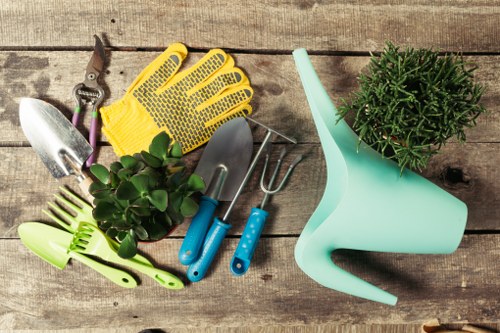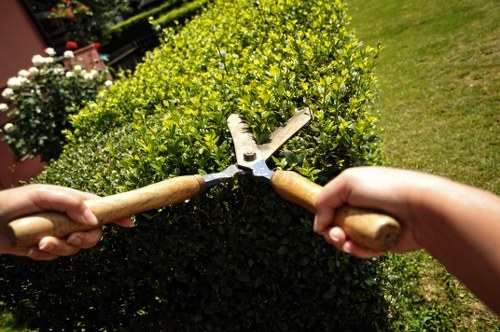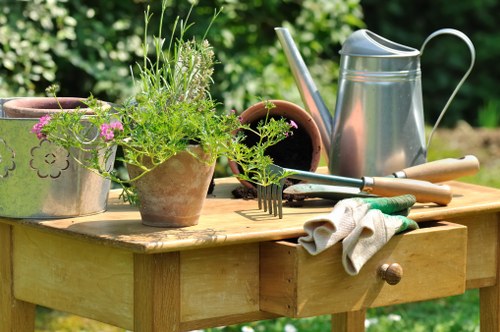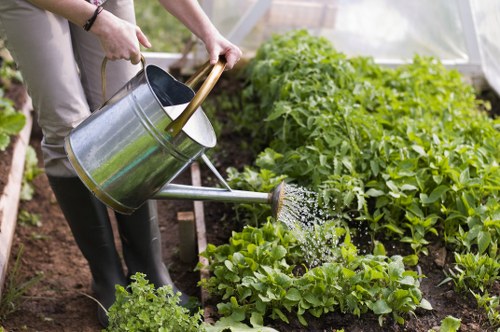Comprehensive Guide to Garden Maintenance in Norbiton
Introduction to Garden Maintenance

Maintaining a beautiful garden in Norbiton requires dedication, knowledge, and the right set of tools. Whether you are a seasoned gardener or a beginner, understanding the essential aspects of garden maintenance can transform your outdoor space into a lush, vibrant oasis. In Norbiton, the climate and soil conditions play a significant role in determining the types of plants that thrive, making localized maintenance strategies crucial for success.
Why Regular Garden Maintenance is Essential
Regular garden maintenance ensures that your plants remain healthy, vibrant, and free from pests and diseases. It also enhances the overall aesthetic appeal of your property, potentially increasing its value. By investing time and effort into garden upkeep, you can enjoy a serene and picturesque environment right in your backyard.
Key Benefits of Garden Maintenance
- Healthier Plants: Regular care prevents diseases and promotes robust growth.
- Enhanced Curb Appeal: A well-maintained garden adds beauty and charm to your home.
- Environmental Benefits: Healthy gardens support local wildlife and contribute to better air quality.
Seasonal Garden Maintenance Tips

Adapting your garden maintenance routine to the changing seasons is vital for ensuring year-round beauty and plant health. Each season presents unique challenges and opportunities for gardeners in Norbiton.
Spring Maintenance
Spring is the perfect time to prepare your garden for the growing season. Start by clearing out any debris that accumulated over the winter months. Prune dead branches, fertilize the soil, and plant new flowers and shrubs to add color and variety.
Spring Tasks Checklist
- Remove weeds and dead plants.
- Prune trees and shrubs.
- Fertilize the soil to provide essential nutrients.
- Plant spring-blooming flowers.
Summer Garden Maintenance Strategies

Summer brings warm weather and longer days, which means your garden will require consistent watering and attention to prevent wilting and pest infestations. Proper irrigation and shade management are key during this season.
Watering Techniques
Efficient watering practices ensure that your plants receive the right amount of moisture without wasting water. Drip irrigation systems and soaker hoses are excellent options for maintaining consistent soil moisture levels.
Summer Care Tips
- Water plants early in the morning to reduce evaporation.
- Mulch garden beds to retain moisture and suppress weeds.
- Monitor for pests and apply natural remedies when necessary.
Autumn Garden Maintenance Essentials

As the temperatures begin to drop, autumn is the time to prepare your garden for the winter months. This involves cleaning up fallen leaves, protecting sensitive plants, and planting bulbs for spring blooms.
Preparing for Winter
Ensuring your garden is ready for winter helps protect your plants from frost and harsh weather conditions. Apply mulch to insulate the soil, cover delicate plants, and store garden tools properly.
Autumn Tasks Checklist
- Rake and compost fallen leaves.
- Plant spring-flowering bulbs.
- Prune perennials and remove spent flowers.
- Protect plants with burlap or frost covers.
Winter Garden Maintenance Tips

Winter may seem like a dormant period for gardens, but proper maintenance can set the stage for a thriving garden in the spring. Focus on planning, tool maintenance, and protecting your plants from extreme cold.
Tool Maintenance
After a year of use, your gardening tools need proper care to ensure they last longer and perform efficiently. Clean, sharpen, and oil your tools to prevent rust and damage.
Winter Care Tips
- Plan your garden layout and select new plants for the upcoming season.
- Inspect and repair garden structures like fences and trellises.
- Protect sensitive plants by mulching and covering them.
Choosing the Right Plants for Norbiton Gardens

Selecting plants that are well-suited to Norbiton's climate and soil conditions is fundamental to successful garden maintenance. Native plants often require less maintenance and are more resilient against local pests and diseases.
Top Native Plants for Norbiton
Some excellent choices for Norbiton gardens include lavender, rosemary, foxgloves, and native grasses. These plants not only thrive in the local environment but also attract pollinators and add natural beauty to your garden.
Flowering Plants
- Lavender: Aromatic and attracts bees.
- Foxgloves: Tall and striking, adding vertical interest.
- Roses: Classic beauty with a variety of colors.
Soil Health and Fertilization

Healthy soil is the foundation of a thriving garden. Understanding soil composition and implementing proper fertilization techniques can significantly improve plant growth and resilience.
Testing and Amending Soil
Conduct a soil test to determine pH levels and nutrient content. Based on the results, amend the soil with organic matter, compost, or specific fertilizers to create an optimal growing environment.
Fertilization Tips
- Use organic fertilizers to promote sustainable growth.
- Apply fertilizers during the growing season for maximum benefit.
- Avoid over-fertilizing, which can harm plants and the environment.
Pest and Disease Management

Protecting your garden from pests and diseases is crucial for maintaining plant health. Implementing integrated pest management strategies can help control unwanted visitors without relying heavily on chemicals.
Identifying Common Pests
Learn to recognize the signs of common garden pests such as aphids, slugs, and caterpillars. Early detection allows for timely intervention to prevent extensive damage.
Natural Remedies
- Neem Oil: Effective against a wide range of insects.
- Beer Traps: Ideal for controlling slugs and snails.
- Handpicking: Manual removal of pests from plants.
Pruning and Trimming Techniques

Regular pruning and trimming are essential for maintaining the shape and health of your plants. Proper techniques encourage growth, improve air circulation, and enhance the overall appearance of your garden.
Best Practices for Pruning
Use sharp, clean tools to make precise cuts. Prune at the right time of year for each plant type to avoid stressing the plants and to promote optimal growth.
Trimming Guidelines
- Remove dead or diseased branches first.
- Cut back overgrown areas to maintain desired shapes.
- Thin out dense foliage to improve light penetration.
Mulching for Garden Health

Mulching plays a vital role in garden maintenance by conserving moisture, suppressing weeds, and regulating soil temperature. It also adds a finished look to your garden beds.
Types of Mulch
Choose from organic mulches like bark, straw, and compost, or inorganic options such as gravel and rubber. Each type has its benefits depending on your garden's needs.
Applying Mulch Effectively
Spread a 2-3 inch layer of mulch around your plants, keeping it away from the stems to prevent rot. Replenish mulch as needed to maintain its effectiveness throughout the year.
Watering Systems and Irrigation

Implementing an efficient watering system is key to successful garden maintenance. Proper irrigation ensures that your plants receive the right amount of water without wastage.
Drip Irrigation Benefits
Drip irrigation delivers water directly to the plant roots, reducing evaporation and runoff. This method is especially beneficial for maintaining consistent soil moisture levels in Norbiton's climate.
Installing an Irrigation System
- Plan your layout to cover all planting areas effectively.
- Choose durable materials to withstand seasonal changes.
- Consider automated timers for convenient and efficient watering.
Garden Tools and Equipment

Having the right tools is essential for efficient garden maintenance. Invest in quality equipment to make gardening tasks easier and more enjoyable.
Essential Garden Tools
Every gardener should have a set of basic tools, including a sturdy spade, pruning shears, a garden fork, and a reliable hose. These tools will help you perform a variety of maintenance tasks with ease.
Maintaining Your Tools
Proper care extends the lifespan of your garden tools. Clean them after each use, store them in a dry place, and lubricate moving parts to prevent rust and wear.
Advanced Equipment
For larger gardens, consider investing in power tools like lawn mowers, trimmers, and hedge cutters to save time and effort.
Remember: Quality tools not only make gardening more efficient but also enhance the overall maintenance experience.
Creating a Sustainable Garden

Sustainability in gardening promotes environmental health and reduces your ecological footprint. Implementing eco-friendly practices can make your garden both beautiful and responsible.
Composting
Composting transforms kitchen and garden waste into rich organic matter that nourishes your plants. It reduces landfill waste and improves soil structure and fertility.
Benefits of Composting
- Enhances soil fertility and structure.
- Reduces the need for chemical fertilizers.
- Supports beneficial microorganisms in the soil.
Attracting Wildlife to Your Garden

A vibrant garden supports a diverse range of wildlife, including birds, bees, and beneficial insects. Attracting these creatures can enhance the health and balance of your garden ecosystem.
Best Wildlife-Friendly Plants
Incorporate plants that provide food and habitat for local wildlife. Flowers like lavender and sunflowers attract pollinators, while shrubs and trees offer shelter and nesting sites.
Creating Wildlife Habitats
- Install birdhouses and bat boxes to provide shelter.
- Create water sources like birdbaths or small ponds.
- Maintain a variety of plant species to support different wildlife needs.
Landscape Design and Aesthetics

A well-designed garden blends functionality with beauty, creating a harmonious outdoor space. Thoughtful landscape design enhances the overall maintenance process by organizing plants and features effectively.
Principles of Effective Landscape Design
Incorporate elements like balance, unity, and focal points to create an aesthetically pleasing garden. Consider the scale and proportion of plants and structures to maintain visual harmony.
Design Tips for Norbiton Gardens
- Symmetry: Create balanced arrangements for a formal look.
- Color Coordination: Choose plant colors that complement each other.
- Texture Variation: Mix different leaf shapes and surface textures for interest.
DIY vs. Professional Garden Maintenance

Deciding between DIY garden maintenance and hiring professionals depends on various factors, including the size of your garden, your expertise, and the time you can commit.
Benefits of DIY Gardening
Taking on garden maintenance yourself can be rewarding and cost-effective. It allows for greater control over the care of your plants and fosters a personal connection with your outdoor space.
When to Hire Professionals
For larger gardens or when facing specific challenges like persistent pests or complex landscape designs, professional garden maintenance services can provide expertise and efficiency.
Consider your needs and resources: If you enjoy gardening and have the time, DIY might be the way to go. Otherwise, professional services can ensure your garden remains pristine with minimal effort on your part.
Eco-Friendly Pest Control Methods

Managing pests in an environmentally responsible manner is essential for maintaining a healthy garden without harming beneficial organisms or the ecosystem.
Biological Pest Control
Introduce natural predators like ladybugs and lacewings to control pest populations. This method reduces the need for chemical interventions and maintains ecological balance.
Organic Pesticides
Use organic solutions such as neem oil, insecticidal soaps, and garlic sprays to manage pests safely. These alternatives are less harmful to the environment and non-target species.
Implementing Pest Barriers
Physical barriers like row covers and netting can prevent pests from reaching your plants, offering a non-chemical approach to pest control.
Pro Tip: Regularly monitor your garden for signs of pest activity to address issues promptly and effectively.
Maximizing Garden Space

Efficient use of garden space ensures that every inch contributes to the beauty and functionality of your outdoor area. Creative planting and structural elements can help you make the most of limited spaces.
Vertical Gardening
Utilize vertical spaces by installing trellises, hanging pots, and vertical planters. This approach not only saves space but also adds depth and interest to your garden design.
Container Gardening
Growing plants in containers offers flexibility and allows you to move plants as needed. It's an excellent option for patios, balconies, and small garden areas.
- Choose the Right Containers: Ensure they have proper drainage and are suitable for the plants you intend to grow.
- Optimize Plant Selection: Select plants that thrive in container environments, such as herbs, flowers, and compact vegetables.
- Arrange Thoughtfully: Group containers by plant type or color for a cohesive and organized look.
Garden Lighting Solutions

Proper lighting enhances the beauty of your garden while providing safety and functionality during evening hours. Integrate lighting to highlight key features and create an inviting atmosphere.
Types of Garden Lighting
Choose from various lighting options, including solar lights, LED fixtures, and string lights. Each type offers unique benefits and can be used to achieve different lighting effects.
Installation Tips
- Plan your lighting layout to ensure even coverage.
- Use timers or smart controls to manage lighting schedules efficiently.
- Incorporate different light intensities to create depth and contrast.
Maintaining Garden Paths and Walkways

Well-maintained paths and walkways contribute to the overall structure and accessibility of your garden. Regular upkeep ensures that these areas remain safe and visually appealing.
Choosing the Right Materials
Select durable and aesthetically pleasing materials such as gravel, paving stones, or natural stone for your garden paths. The right choice enhances the garden's look and complements its style.
Path Maintenance Tips
- Remove weeds and debris regularly to prevent overgrowth.
- Repair cracks and uneven surfaces promptly to ensure safety.
- Refresh the edging to maintain a defined boundary.
Integrating Hardscapes into Your Garden

Hardscapes, such as patios, decks, and stone features, add functionality and visual interest to your garden. Proper integration enhances the overall design and provides practical spaces for relaxation and entertainment.
Benefits of Hardscaping
Incorporating hardscape elements can create defined spaces, improve garden structure, and increase property value. They also offer surfaces for seating, dining, and social gatherings.
Design Considerations
- Ensure hardscape materials complement the garden's aesthetic.
- Plan for proper drainage to prevent water pooling.
- Incorporate lighting and landscaping around hardscape areas for a cohesive look.
Comprehensive Garden Maintenance Checklist

Staying organized with a garden maintenance checklist ensures that you cover all essential tasks throughout the year. A systematic approach helps maintain garden health and beauty consistently.
Monthly Maintenance Tasks
Keeping track of monthly tasks can help you stay on top of garden maintenance without feeling overwhelmed.
Sample Checklist
- January: Plan garden layout and order seeds.
- February: Prune trees and shrubs.
- March: Start planting early spring vegetables.
- April: Apply mulch and fertilize beds.
- May: Monitor for pests and diseases.
- June: Implement summer watering strategies.
- July: Harvest ripe vegetables and fruits.
- August: Prepare for autumn planting.
- September: Rake leaves and compost.
- October: Plant bulbs for spring blooms.
- November: Protect plants from frost.
- December: Review garden performance and plan for next year.
Eco-Friendly Garden Practices

Embracing eco-friendly garden practices not only benefits the environment but also creates a healthier and more sustainable garden. Implementing green methods can lead to long-term success and minimal ecological impact.
Rainwater Harvesting
Collecting and utilizing rainwater reduces dependency on municipal water sources and provides plants with naturally soft water, free from chemicals.
How to Harvest Rainwater
- Install rain barrels or cisterns at downspouts to collect runoff.
- Use first-flush diverters to keep debris out of storage containers.
- Connect your harvesting system to your garden's irrigation setup.
Organic Gardening
Focus on using natural fertilizers, pest control methods, and sustainable gardening techniques to promote a balanced ecosystem.
Benefits of Organic Gardening
- Reduces chemical runoff and soil contamination.
- Enhances soil health through natural amendments.
- Supports biodiversity by creating a habitat for beneficial organisms.
Conclusion: Achieving a Thriving Garden in Norbiton

Effective garden maintenance in Norbiton involves a combination of regular care, strategic planning, and sustainable practices. By following the guidelines outlined in this article, you can cultivate a beautiful and healthy garden that serves as a sanctuary for both you and local wildlife.
Final Tips for Garden Success
- Stay informed about local gardening trends and plant varieties.
- Join local gardening groups or forums to share knowledge and experiences.
- Continuously evaluate and adjust your maintenance strategies based on garden performance.
Get Started Today
Ready to transform your garden?
Contact us today to book your garden maintenance service and enjoy a lush, vibrant garden all year round.
 Maintaining a beautiful garden in Norbiton requires dedication, knowledge, and the right set of tools. Whether you are a seasoned gardener or a beginner, understanding the essential aspects of garden maintenance can transform your outdoor space into a lush, vibrant oasis. In Norbiton, the climate and soil conditions play a significant role in determining the types of plants that thrive, making localized maintenance strategies crucial for success.
Maintaining a beautiful garden in Norbiton requires dedication, knowledge, and the right set of tools. Whether you are a seasoned gardener or a beginner, understanding the essential aspects of garden maintenance can transform your outdoor space into a lush, vibrant oasis. In Norbiton, the climate and soil conditions play a significant role in determining the types of plants that thrive, making localized maintenance strategies crucial for success.  Adapting your garden maintenance routine to the changing seasons is vital for ensuring year-round beauty and plant health. Each season presents unique challenges and opportunities for gardeners in Norbiton.
Adapting your garden maintenance routine to the changing seasons is vital for ensuring year-round beauty and plant health. Each season presents unique challenges and opportunities for gardeners in Norbiton.  Summer brings warm weather and longer days, which means your garden will require consistent watering and attention to prevent wilting and pest infestations. Proper irrigation and shade management are key during this season.
Summer brings warm weather and longer days, which means your garden will require consistent watering and attention to prevent wilting and pest infestations. Proper irrigation and shade management are key during this season.  As the temperatures begin to drop, autumn is the time to prepare your garden for the winter months. This involves cleaning up fallen leaves, protecting sensitive plants, and planting bulbs for spring blooms.
As the temperatures begin to drop, autumn is the time to prepare your garden for the winter months. This involves cleaning up fallen leaves, protecting sensitive plants, and planting bulbs for spring blooms.  Winter may seem like a dormant period for gardens, but proper maintenance can set the stage for a thriving garden in the spring. Focus on planning, tool maintenance, and protecting your plants from extreme cold.
Winter may seem like a dormant period for gardens, but proper maintenance can set the stage for a thriving garden in the spring. Focus on planning, tool maintenance, and protecting your plants from extreme cold.  Selecting plants that are well-suited to Norbiton's climate and soil conditions is fundamental to successful garden maintenance. Native plants often require less maintenance and are more resilient against local pests and diseases.
Selecting plants that are well-suited to Norbiton's climate and soil conditions is fundamental to successful garden maintenance. Native plants often require less maintenance and are more resilient against local pests and diseases.  Healthy soil is the foundation of a thriving garden. Understanding soil composition and implementing proper fertilization techniques can significantly improve plant growth and resilience.
Healthy soil is the foundation of a thriving garden. Understanding soil composition and implementing proper fertilization techniques can significantly improve plant growth and resilience.  Protecting your garden from pests and diseases is crucial for maintaining plant health. Implementing integrated pest management strategies can help control unwanted visitors without relying heavily on chemicals.
Protecting your garden from pests and diseases is crucial for maintaining plant health. Implementing integrated pest management strategies can help control unwanted visitors without relying heavily on chemicals.  Regular pruning and trimming are essential for maintaining the shape and health of your plants. Proper techniques encourage growth, improve air circulation, and enhance the overall appearance of your garden.
Regular pruning and trimming are essential for maintaining the shape and health of your plants. Proper techniques encourage growth, improve air circulation, and enhance the overall appearance of your garden.  Mulching plays a vital role in garden maintenance by conserving moisture, suppressing weeds, and regulating soil temperature. It also adds a finished look to your garden beds.
Mulching plays a vital role in garden maintenance by conserving moisture, suppressing weeds, and regulating soil temperature. It also adds a finished look to your garden beds.  Implementing an efficient watering system is key to successful garden maintenance. Proper irrigation ensures that your plants receive the right amount of water without wastage.
Implementing an efficient watering system is key to successful garden maintenance. Proper irrigation ensures that your plants receive the right amount of water without wastage.  Having the right tools is essential for efficient garden maintenance. Invest in quality equipment to make gardening tasks easier and more enjoyable.
Having the right tools is essential for efficient garden maintenance. Invest in quality equipment to make gardening tasks easier and more enjoyable.  Sustainability in gardening promotes environmental health and reduces your ecological footprint. Implementing eco-friendly practices can make your garden both beautiful and responsible.
Sustainability in gardening promotes environmental health and reduces your ecological footprint. Implementing eco-friendly practices can make your garden both beautiful and responsible.  A vibrant garden supports a diverse range of wildlife, including birds, bees, and beneficial insects. Attracting these creatures can enhance the health and balance of your garden ecosystem.
A vibrant garden supports a diverse range of wildlife, including birds, bees, and beneficial insects. Attracting these creatures can enhance the health and balance of your garden ecosystem.  A well-designed garden blends functionality with beauty, creating a harmonious outdoor space. Thoughtful landscape design enhances the overall maintenance process by organizing plants and features effectively.
A well-designed garden blends functionality with beauty, creating a harmonious outdoor space. Thoughtful landscape design enhances the overall maintenance process by organizing plants and features effectively.  Deciding between DIY garden maintenance and hiring professionals depends on various factors, including the size of your garden, your expertise, and the time you can commit.
Deciding between DIY garden maintenance and hiring professionals depends on various factors, including the size of your garden, your expertise, and the time you can commit.  Managing pests in an environmentally responsible manner is essential for maintaining a healthy garden without harming beneficial organisms or the ecosystem.
Managing pests in an environmentally responsible manner is essential for maintaining a healthy garden without harming beneficial organisms or the ecosystem.  Efficient use of garden space ensures that every inch contributes to the beauty and functionality of your outdoor area. Creative planting and structural elements can help you make the most of limited spaces.
Efficient use of garden space ensures that every inch contributes to the beauty and functionality of your outdoor area. Creative planting and structural elements can help you make the most of limited spaces.  Proper lighting enhances the beauty of your garden while providing safety and functionality during evening hours. Integrate lighting to highlight key features and create an inviting atmosphere.
Proper lighting enhances the beauty of your garden while providing safety and functionality during evening hours. Integrate lighting to highlight key features and create an inviting atmosphere.  Well-maintained paths and walkways contribute to the overall structure and accessibility of your garden. Regular upkeep ensures that these areas remain safe and visually appealing.
Well-maintained paths and walkways contribute to the overall structure and accessibility of your garden. Regular upkeep ensures that these areas remain safe and visually appealing.  Hardscapes, such as patios, decks, and stone features, add functionality and visual interest to your garden. Proper integration enhances the overall design and provides practical spaces for relaxation and entertainment.
Hardscapes, such as patios, decks, and stone features, add functionality and visual interest to your garden. Proper integration enhances the overall design and provides practical spaces for relaxation and entertainment.  Staying organized with a garden maintenance checklist ensures that you cover all essential tasks throughout the year. A systematic approach helps maintain garden health and beauty consistently.
Staying organized with a garden maintenance checklist ensures that you cover all essential tasks throughout the year. A systematic approach helps maintain garden health and beauty consistently.  Embracing eco-friendly garden practices not only benefits the environment but also creates a healthier and more sustainable garden. Implementing green methods can lead to long-term success and minimal ecological impact.
Embracing eco-friendly garden practices not only benefits the environment but also creates a healthier and more sustainable garden. Implementing green methods can lead to long-term success and minimal ecological impact.  Effective garden maintenance in Norbiton involves a combination of regular care, strategic planning, and sustainable practices. By following the guidelines outlined in this article, you can cultivate a beautiful and healthy garden that serves as a sanctuary for both you and local wildlife.
Effective garden maintenance in Norbiton involves a combination of regular care, strategic planning, and sustainable practices. By following the guidelines outlined in this article, you can cultivate a beautiful and healthy garden that serves as a sanctuary for both you and local wildlife. 